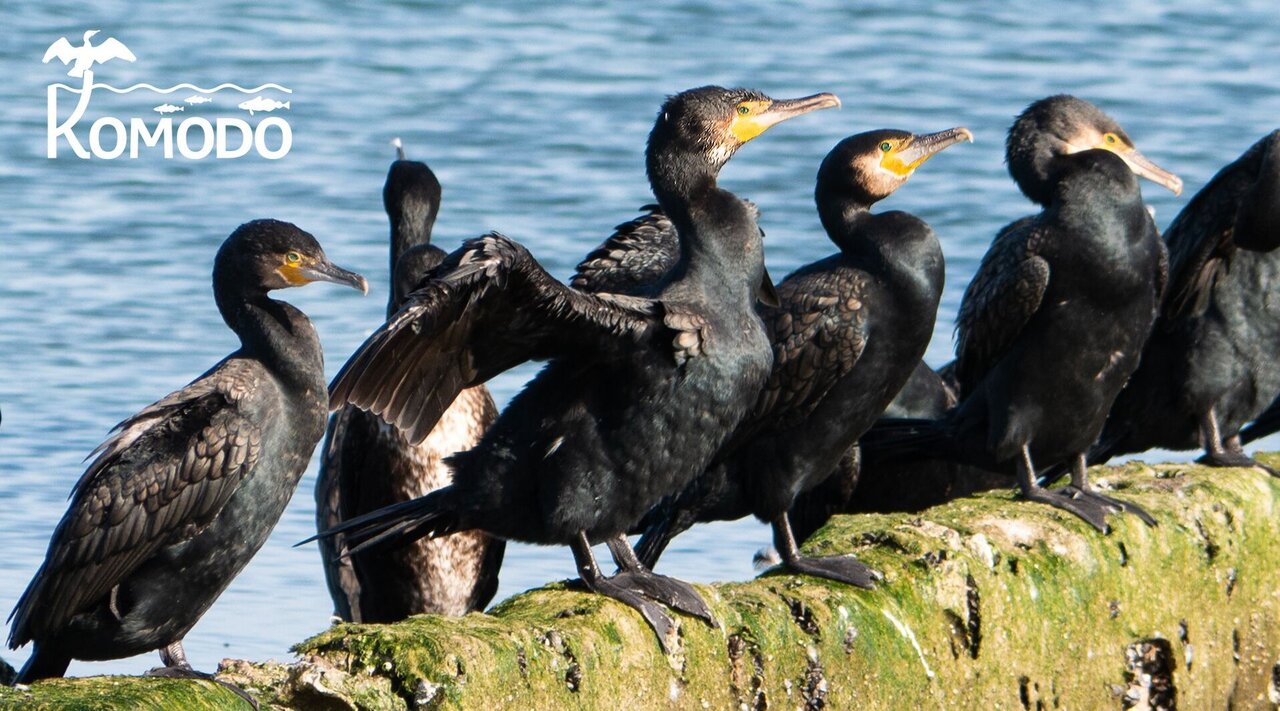Project
KOMODO - Estimation of cormorant-induced mortality in western Baltic cod

KOMODO - Estimation of cormorant-induced mortality in western Baltic cod
The cod stock in the western Baltic Sea is in a historically poor state. The stock shows no signs of recovery, although fishing pressure has been low for years. The majority of juvenile cod produced by the few remaining parents do not seem to make it to adulthood. Cormorants are once again widespread along the coasts and also eat cod, especially smaller specimens. How much cod do the cormorants eat and what role do cormorants play in non-recovery of the cod stock in the western Baltic Sea?
Background and Objective
Poor state of the cod stock
The cod stock in the western Baltic Sea is in a historically poor state. The stock has fewer adult than at any time since the 1980s and the production of young cod has been far below the long-term average since 2017; the last stronger year class was produced in 2016 (ICES 2022). Despite a sharp reduction in fishing effort, including the cessation of directed fishing for cod, there is no sign of a recovery in the cod stock. It is likely that non-fishing factors such as warming, eutrophication, habitat loss and an increase in natural mortality will play an important role in the further development (Bryhn et al. 2022). In this context, the predation of cod by cormorants is also of particular interest.
Possible role of cormorants
The cormorant population in the south-western Baltic Sea region (Denmark, Germany with the federal states of Schleswig-Holstein and Mecklenburg-Western Pomerania) rose sharply from 1970 to 1995 and has remained largely constant at just under 50,000 breeding pairs since then (Koop 2020). This relatively high number of cormorants is perceived by fishers as competition and a threat to fish stocks and their management (DFV 2022). Currently, the level and development of fish predation by cormorants is not taken into account when modelling the stock dynamics of western Baltic cod. However, the results of recent studies suggest potential impacts of cormorants on fish stocks and fisheries along the Baltic Sea coast (Bryhn et al. 2022; Haase et al. 2021; Pietrock et al. 2021).
The initial results of a recently completed IfB study revealed that cormorants at a roosting site on Lake Dassow near the Bay of Lübeck had an unexpectedly high proportion of juvenile cod in their diet (Pietrock et al. 2021) and highlighted the potential role of natural mortality in the poor state of the western Baltic cod stock. The monthly diet of cormorants at this site consisted of 25 % to 96 % cod (based on estimated biomass), with predation mainly on zero, one- and two-year-old cod between 12 and 43 cm (Pietrock et al. 2021).
However, these results are from only one site and the temporal variability was very high. Other studies along the coast of Mecklenburg-Western Pomerania also showed high local fluctuations in the biomass proportions of cod, between 0 and 46 % (H. Winkler, personal communication). It is therefore still unclear to what extent the results of Pietrock et al. (2021) are representative for other locations and years. Further studies are required for a more reliable assessment of the possible influence of cormorant predation on the dynamics, status and development prospects of the western Baltic cod stock and other fish species in the region.
Study objectives
A better understanding of the causes of stock dynamics is important in order to better assess the chances of recovery of the western Baltic cod stock and thus also the prospects of any fisheries exploitation in the future.
This study will focus on the following main areas:
- Quantification of cormorant predation on selected stretches of the Baltic Sea coast with a particular focus on cod,
- Comparison of conventional and novel genetically based methods to quantify fish predation from cormorant food pellet analyses, and
- Assessment of the potential impact of natural mortality by cormorants on the population dynamics of cod in the western Baltic Sea.
Target Group
Fishers, anglers, ornithologists, (fisheries) biologists, environmental protection groups, politicians, interested members of the public and others
Approach
This project is based on close co-operation between the Institute of Inland Fisheries e.V. Potsdam Sacrow, the Thünen Institute of Baltic Sea Fisheries, the Fraunhofer Institute for Cell Therapy and Immunology: Bioanalytics and Bioprocesses Branch, and several ornithologists in Germany and Denmark. As a result, special expertise from various fields is incorporated into the work, e.g. expertise in inland and Baltic Sea fisheries, in food pellet analysis, cod and cormorant ecology and population dynamics as well as in the age determination of cod.
Our Research Questions
The project comprises the following work packages:
1. lierature research and coordination between partners regading the topic cormorant and fish predation
2. sampling of cormorant pellets and collection of data on cormorants
3. Determination of relative abundances and weights of different fish species and the age composition of cod flatfishes in cormorant pellets using conventional methods
4. Testing of new genetic and other methods to quantify the proportion of different fish species in cormorant pellets
5. Estimation of the share of cod and other fish species in the annual diet composition of cormorants
6. Tagging of cod and other target species using PIT tags
7. Collection and analysis of population level data of cod and other fish species
8. Estimation of the potential role of cormorant predation on the population dynamics of western Baltic cod
9. Developing a regional monitoring plan to assess cormorant predation as a potential contribution to the western Baltic cod stock assessment of ICES
10. Presentation, publication and reporting of project results
Legal classification of the protection and management of cormorants
In Europe, cormorants are subject to general protection under the EU Birds Directive (Directive 2009). Due to their rapid recovery, the status of cormorants as a specially protected species was lifted in 1997, meaning that they are no longer listed in Appendix I of the Federal Species Protection Provision.
Hunting cormorants is generally not permitted in Germany, as the cormorant is not subject to hunting law (not a huntable species). Exceptions for the shooting of cormorants can therefore only be made on the basis of the nature conservation law. The basis for this is the Federal Nature Conservation Act and the reasons for exemption enshrined therein: "to prevent serious damage to agriculture, forestry, fisheries or water management or other serious economic damage, to protect naturally occurring flora and fauna, .... These "removals" of cormorants, which are authorized under nature conservation law, are only equivalent to hunting under firearms law. This makes it possible for authorized persons to transport and use hunting weapons in the same way as is permitted in the context of normal hunting, without the need for further permits under firearms law (e.g. firearms license, exemption under firearms law, etc.). The responsibility for such exceptions lies with the nature conservation authorities.
EU law expressly permits interventions in populations of protected species to prevent damage (in the case of birds, see Art. 9 of the EU Birds Directive; otherwise, the Habitats Directive) - this also applies in full to the cormorant. However, the EU has also recently denied any responsibility for international management and refers to the responsibility of the member states and considers regional solutions to be sufficient or even more suitable.
In Germany, the federal states are responsible for the implementation of regulatory interventions in populations of protected species. The federal states, on the other hand, have no external representation competence, e.g. for coordination with neighboring member states; this could only be done via the federal government. At federal level, where the Federal Ministry for the Environment is responsible, there has so far been no support for the issue of cormorant management.
This creates a seemingly irresolvable legal dilemma for cormorant management: from a purely technical point of view, the framework for management should be "large" and ideally cover the entire (northern) European distribution area, including the breeding areas in the Scandinavian and Baltic countries. It is known from numerous studies that cormorants have a large radius of action. They cover distances of more than 1,000 km in a year between breeding, resting and wintering areas and can also change breeding sites several times over large distances in the course of their lives. It therefore makes very little technical sense to intervene at the level of a federal state (or even Germany) to "regulate" the population, as local "gaps" are very quickly closed by migrating cormorants. A "real" sustainable management of the species would have to start at the breeding colonies and bring about a massive large-scale reduction in the overall population. Activities at state level appear to make little sense here.
Nevertheless, small local interventions are occasionally made (see cormorant provision) - for example, to protect pond systems or to reduce the pressure from cormorants on particularly endangered streams or rivers in order to protect fish species. However, permanent intervention is required here, as the existing food resources continue to attract cormorants from the surrounding area.
Literature
DIRECTIVE 2009/147/EC OF THE EUROPEAN PARLIAMENT AND OF THE COUNCIL of November 30, 2009 on the conservation of wild birds
ICES 2021 Inter-Benchmark Process on Western Baltic cod (IBPWEB). ICES Scientific Reports. 3: 87. 76 pp. doi.org/10.17895/ices.pub.5257.2021
Pietrock et al. 2022. Analysis of spit balls to determine the food composition of cormorants in the Plöner Seen, Untertrave and Schlei areas: Institute of Inland Fisheries Potsdam. 2021.
Acknowledgments
Stephanie Jansch, Schleswig-Holstein State Office for Agriculture and Sustainable Land Development, Department 31, kindly provided the basic framework for the text on legal classification.
Links and Downloads
Literature:
- Bryhn, A. C., Bergek, S., Bergström, U., Casini, M., Dahlgren, E., Ek, C., Hjelm, J., Königson, S., Ljungberg, P., Lundström, K., Lunneryd, S. G., Ovegård, M., Sköld, M., Valentinsson, D., Vitale, F., & Wennhage, H. (2022). Which factors can affect the productivity and dynamics of cod stocks in the Baltic Sea, Kattegat and Skagerrak? Ocean & Coastal Management, 223, 106154. doi.org/10.1016/j.ocecoaman.2022.106154
ICES. 2022. Cod (Gadus morhua) in subdivisions 22–24, western Baltic stock (western Baltic Sea). ICES Advice: Recurrent Advice. Report. doi.org/10.17895/ices.advice.19447868.v1 - Koop, B. 2020. Ornithologische Begleituntersuchungen zum Kormoran: Bericht für 2020 vorgelegt im Auftrag des Ministeriums für Energiewende, Landwirtschaft, Umwelt, Natur und Digitalisierung des Landes Schleswig-Holstein, Kiel.
- Deutscher Fischerei-Verband e.V. (DFV). 2022. Kormorane fressen mehr Dorsch, als Fischer fangen dürfen. Natürlich Jagd. www.natuerlich-jagd.de/im-original/kormorane-fressen-mehr-dorsch-als-fischer-fangen-duerfen/
- Haase, S., K. Hüssy, M. Casini, K. Radtke, & U. Krumme. (2021). Eaten by a cormorant: Unexpected return of a tagged Baltic cod. 2021 International Workshop on Metrology for the Sea; Learning to Measure Sea Health Parameters (MetroSea), 283–287. doi.org/10.1109/MetroSea52177.2021.9611573
- Pietrock, M.; Sternberg, N. 2021. Analyse von Speiballen zur Ermittlung der Nahrungs-zusammensetzung von Kormoranen in den Gebieten Plöner Seen, Untertrave und Schlei. Bericht im Auftrag des Ministeriuma für Energiewende, Landwirtschaft, Umwelt, Natur und Digitalisierung des Landes Schleswig-Holstein. Institut für Binnenfischerei e. V. Potsdam-Sacrow, 90 pp.
- Kieckbusch, J.J. & B. Koop. 1996. Brutbestand, Rastverbreitung und Nahrungsökologie des Kormorans (Phalacrocorax carbo sinensis) in Schleswig-Holstein. Corax 16: 335-355.
Thünen-Contact

Involved Thünen-Partners
Involved external Thünen-Partners
- Institut für Binnenfischerei e.V. Potsdam-Sacrow
(Potsdam, Deutschland) - Aarhus University
(Aarhus, Tjele, Dänemark)
Funding Body
-
Bundesland Schleswig-Holstein
(national, öffentlich)
Duration
7.2023 - 6.2027
More Information
Project status:
ongoing

![[Translate to English:] [Translate to English:]](/media/_processed_/d/7/csm_Startseite-OF_03_c0dfd6e750.png)
![[Translate to English:] [Translate to English:]](/media/_processed_/a/3/csm_20181116-151457-Stella-Jerome-Fischfalle-Warnem%C3%BCnde-Dorsche-im-Netzk%C3%A4fig-5691_heller_3050c72fa2.png)





